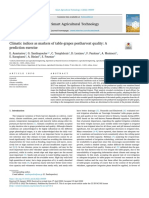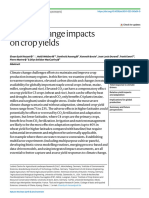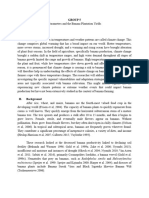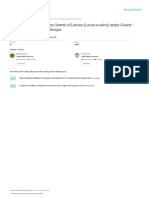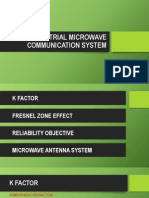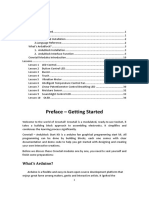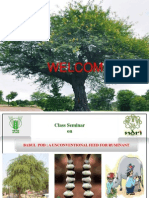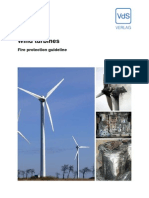Climatic Effects On Sugarcane Ripening Under The in Uence of Cultivars and Crop Age
Climatic Effects On Sugarcane Ripening Under The in Uence of Cultivars and Crop Age
Uploaded by
AnnyCopyright:
Available Formats
Climatic Effects On Sugarcane Ripening Under The in Uence of Cultivars and Crop Age
Climatic Effects On Sugarcane Ripening Under The in Uence of Cultivars and Crop Age
Uploaded by
AnnyOriginal Title
Copyright
Available Formats
Share this document
Did you find this document useful?
Is this content inappropriate?
Copyright:
Available Formats
Climatic Effects On Sugarcane Ripening Under The in Uence of Cultivars and Crop Age
Climatic Effects On Sugarcane Ripening Under The in Uence of Cultivars and Crop Age
Uploaded by
AnnyCopyright:
Available Formats
See discussions, stats, and author profiles for this publication at: https://www.researchgate.
net/publication/260766149
Climatic effects on sugarcane ripening under the influence of cultivars and crop
age
Article in Scientia Agricola · December 2013
DOI: 10.1590/S0103-90162013000600011
CITATIONS READS
38 497
2 authors:
Nilceu Piffer Cardozo Paulo Cesar Sentelhas
São Paulo State University University of São Paulo
24 PUBLICATIONS 114 CITATIONS 221 PUBLICATIONS 4,290 CITATIONS
SEE PROFILE SEE PROFILE
Some of the authors of this publication are also working on these related projects:
Interações em sistema silvipastoril: microclima, produção de forragem e parametrização de modelo para estimativa da produtividade de pastagens de Brachiaria View
project
Parameterization and evaluation of mechanistic crop simulation models to estimate Urochloa brizantha cv. Piatã productivity in a silvopastoral system View project
All content following this page was uploaded by Nilceu Piffer Cardozo on 11 July 2014.
The user has requested enhancement of the downloaded file.
449
Cardozo & Sentelhas Scientia Agricola
Climatic effects on sugarcane ripening
Review
Climatic effects on sugarcane ripening under the influence of cultivars and crop age
Nilceu Piffer Cardozo*, Paulo Cesar Sentelhas
USP/ESALQ – Depto. de Engenharia de Biossistemas, Av. ABSTRACT: The lack of information about the effects of cultivars, crop age and climate on the
Pádua Dias, 11 – C.P. 9 – 13418-900 – Piracicaba, SP – sugarcane (Saccharum ssp.) crop yield and quality has been the primary factor impacting the
Brasil. sugar-ethanol sector in Brazil. One of the processes about which we do not have a satisfac-
*Corresponding author <nilceu.cardozo@terra.com.br> tory understanding is sugarcane ripening and the effects of cultivars, crop age and climate
on that. Sugarcane ripening is the process of sucrose accumulation in stalks, which is heavily
Edited by: Daniel Scherer de Moura influenced by several factors, mainly by climatic conditions such as air temperature and water
deficits. Because it is a complex process, studies of the variables involved in sugarcane ripening
can provide important information, resulting in a better use of commercial cultivars, bringing
advantages to growers, processing units, breeding programs and scientific community. In this
review, we discuss the available knowledge of the interaction between climate conditions and
sugarcane ripening, under the influence of genotypic characteristics and crop age. In several
studies, the main conclusion is that sugarcane ripening depends on a complex combination of
climate variables, the genetic potential of cultivars and crop management. Soil moisture and
air temperature are the primary variables involved in sugarcane ripening, and their combination
stimulates the intensity of the process. In addition, the need for studies integrating the effects
of climate on plant physiological processes and on the use of chemical agents to stimulate
Received January 10, 2013 sugarcane ripening is highlighted.
Accepted June 28, 2013 Keywords: Saccharum spp., air temperature, precipitation, water deficit, sucrose
Introduction Studies that organize the knowledge available for
over 50 years, updated with new studies developed in re-
Climate has been the major factor affecting sug- cent years, are extremely important for the development
arcane (Saccharum ssp.) production in recent seasons in of the sugar-ethanol sector and for the determination
Brazil. The 2009/10 season was marked by several peri- of what new studies should be performed. This review
ods with large water surplus associated with an El Niño aims to discuss the effects of climate variables on sugar-
event, while 2010/11 presented an intense and prolonged cane ripening, in addition to the effects of genotypes and
drought, associated with a La Niña event. The 2011/12 crop age. Moreover, we highlight the results obtained in
season experienced a combination of large water surplus recent years, which question common knowledge and
at the beginning of the year, two frosts in late fall and indicate the need for further research to increase the
early winter and an intense water deficit from the middle comprehension of the sugarcane ripening process.
to the end of the season. Each of these scenarios brought
unique consequences to sugarcane yield and quality and Sugarcane ripening
constitutes a clear example of how climate conditions Clements (1962) described sugarcane ripening as a
can impact the Brazilian sugar-ethanol sector. physiological senescence that occurs between the phas-
Clements (1962), Lingle and Irvine (1994) and es of growth and plant death. Generally, ripening is the
Robertson and Donaldson (1998) have studied sugarcane process of sucrose accumulation in sugarcane stalks (Leg-
ripening around the world. In most of the recent studies endre, 1975), which occurs from the basal internodes to the
Lingle (2004), Inman-Bamber et al. (2009), Leite et al. apex, until they reach a common value (Alexander, 1973).
(2011) and Silva and Caputo (2012) have discussed the In this way, sugarcane stalks are the reservoir where, un-
effects of chemical agents (ripeners) or the biochemistry der favorable conditions, large amounts of sucrose are ac-
of the process rather than the natural variables that in- cumulated. Sugarcane stalks are composed of successions
fluence ripening. The main studies on the effects of cli- of internodes in different physiological stages, issued at
mate on sugarcane ripening were produced between the intervals of approximately ten days. During growth, su-
1950s and 1970s (Clements, 1962; Glasziou et al., 1964; crose content is always greater in basal internodes (older)
Waldron et al., 1967; Alexander and Samuels, 1968; Leg- and lower in younger ones in the top of the stalks. These
endre, 1975). Much of the information produced at that immature internodes have green leaves, are fibrous and
time has not been consolidated and organized in such a have high hexose concentrations and low sucrose levels.
way that allows these studies to be used in crop planning As immature internodes develop, their growth rates de-
and decision-making based on the current conditions of crease until growth is almost completely stopped when
the sugar-ethanol sector in Brazil. the internodes are ripened (Glasziou et al., 1964).
Sci. Agric. v.70, n.6, p.449-456, November/December 2013
450
Cardozo & Sentelhas Climatic effects on sugarcane ripening
The ripening point is determined primarily by is between the second half of Aug and the first half of
the levels of sucrose, reducing sugars and stalk humid- Oct in Southern Brazil (Scarpari and Beauclair, 2004).
ity during the crop season. According to the Brazilian The ripening of sugarcane cultivars is significantly
Sugarcane, Sugar and Ethanol Producers Council (CON- variable in the early season, when the precocity of cul-
SECANA) standards, millable cane, i.e., stalks that have tivars really leads to differences in sugar yield (Cardozo,
the technological and economic conditions for industrial 2012). However, as the harvesting season progresses, the
processing, need sucrose (Pol) levels of at least 12.257 variation among cultivars in terms of sugar content de-
% (Lavanholi, 2008). Early cultivars are those with Pol creases, and the classification of the cultivars as early-,
levels greater than 12.257 % at the beginning of the har- middle- or late-ripening is no longer evident (Table 1).
vesting season, while middle and late cultivars possess Cardozo (2012) emphasizes that although the differences
Pol concentrations above this threshold from the middle in Pol values among cultivars have been reduced dur-
to the end of the season (Lavanholi, 2008). ing the harvesting season, early cultivars usually tend to
The sucrose levels vary during the harvesting sea- keep the highest Pol levels, even though this difference
son, with higher accumulation rates observed during the was not as expressive as in the early season. This fact
last phase of the sugarcane cycle, when the plant has a was also reported by Stuppiello (1987), who observed
low growth rate, which is conditioned by adverse weather that the mid-season sugarcane cultivars rarely reach the
conditions (Alexander, 1973). In Southeastern Brazil, the maximum sucrose levels obtained by the early cultivars,
lower air temperature in the fall-winter months combined and similarly, the late cultivars rarely reach the sucrose
with the occurrence of a moderate water deficit are the levels of the mid-season cultivars.
major ripening factors, which result in a very rapid in- The response of sugarcane cultivars to environmen-
crease in sucrose content. Cardozo (2012) indicated that tal conditions is commonly attributed to the differences in
the sucrose stalk content in the four months before har- their physiology. Singh and Venkatarama (1983) and Lin-
vesting increased from 7.32 % to 15.29 % ( 110 %), while gle and Irvine (1994) observed the highest relative growth
the total biomass only increased from 122 to 132 t ha–1 rates and net sucrose accumulations during stalk elonga-
( 8 %). Therefore, despite the intense work of breeding tion and ripening of early cultivars when compared to
programs to produce earlier-ripening cultivars, sugarcane late ones. Early cultivars tend to have more synchronized
rarely achieves its full ripening potential, as it is harvested tillering phases and develop complete internodes earlier.
while still actively accumulating sucrose (Legendre, 1975), The early-ripening cultivars are more physiologically ef-
especially in the first months of harvesting season, when ficient because they use the photosynthates in a more
the air temperature and soil moisture are usually high. effective way and complete their vegetative growth faster
than late-ripening cultivars (Mamet and Galwey, 1999).
Ripening and cultivar characteristics Thus, they would be physiologically able to change from
The genotype can affect the response of sugarcane a vegetative development phase to ripening earlier than
to meteorological variables, such as air temperature, pre- the late cultivars. Singh and Venkatarama (1983) suggest-
cipitation, soil moisture and solar radiation (Brodie et ed that early-ripening cultivars had a lower ratio of acid
al., 1969). Sugarcane cultivars differ in how long they and neutral invertases, favoring the ripening process.
take to ripen, with early cultivars tending to be more Sugarcane cultivars have distinct reactions in relation to
sensitive to weather conditions and therefore ripening invertase activity and sugar levels. Early cultivars tend
sooner. Meanwhile, the late cultivars are less sensitive to have higher levels of neutral invertase activity earlier
to weather conditions for ripening, reaching the highest than late cultivars, resulting in higher sucrose accumula-
sucrose levels in the end of the harvesting season, which tion and low levels of reducing sugars.
Table 1 – Pol levels of eight sugarcane cultivars over the months of the 2003 season in Piracicaba, State of São Paulo, Brazil.
Cultivars Mar Apr May June July Aug Sept Oct
--------------------------------------------------------------------------------------------------------------------- % --------------------------------------------------------------------------------------------------------------
SP91-1049 9.82 11.34 13.23 14.81 15.35 16.22 16.75 17.09
SP90-3414 7.25 9.15 11.27 13.14 14.40 15.67 16.59 17.12
SP87-365 6.65 9.21 10.87 12.57 13.34 15.16 16.13 16.61
SP86-42 6.02 8.54 10.30 12.27 13.18 14.72 15.78 16.54
SP86-155 8.61 10.18 12.54 13.87 15.12 15.74 16.17 16.79
SP83-2847 5.97 8.24 10.37 11.67 12.69 14.33 15.79 16.20
RB928064 7.12 9.52 11.83 12.44 13.44 15.20 15.75 16.69
RB867515 7.12 8.56 11.59 12.60 13.69 15.30 15.48 16.89
Mean 7.32 9.34 11.50 12.92 13.90 15.29 16.06 16.74
SD 1.31 1.02 1.03 1.00 0.96 0.60 0.44 0.30
CV (%) 18 11 9 8 7 4 3 2
Source: Cardozo (2012).
Sci. Agric. v.70, n.6, p.449-456, November/December 2013
451
Cardozo & Sentelhas Climatic effects on sugarcane ripening
Ripening and crop age problem with sugarcane biomass sampling is that it is
From a physiological point of view, the processes rarely performed in terms of the dry matter of all its
of ageing, maturity and ripening are not synonymous, components, including pointers, stalks, straw, leaves and
although they are usually considered to be so (Alexan- roots; which makes the inter-comparisons of results very
der, 1973). Maturity has different meanings for differ- difficult (Evensen et al., 1997).
ent professionals involved with sugarcane production,
the most correct being the botanical completion of a Ripening and flowering
stalk, suitable for producing new plantlets from each Another factor that affects sugarcane ripening is
node. In this case, the stalks will contain stored sug- the flowering process (Silva and Caputo, 2012). Sugar-
ars to support reproduction, but the storage potential cane flowering is influenced by photoperiod, tempera-
of the stalks has not necessarily been achieved. There- ture, rainfall, nutritional status, soil moisture, cultivar
fore, maturity is not synonymous with age because if and crop management, and is highly undesirable from
water and nitrogen supplies are continuously available the sugar production point of view (Alexander, 1973;
to the plants, they may never reach maturity regard- Pereira et al., 1983). Flowering intensity and the conse-
less their age. Moreover, maturity is not synonymous quences on the juice quality vary according to the inter-
with ripening because sugarcane can be easily ripened action between the cultivar and the climate. Reduction
within a few months after germination if subjected to of the sucrose and the increase of fiber are the main
water, thermal or nutrient stress. These plants, how- consequences of the flowering process.
ever, are not mature in any way. From the grower’s For the majority of sugarcane cultivars used com-
point of view, maturity, age and ripening have become mercially, the required photoperiod in order to induce
closely linked in such a way that the ripening process flowering is between 12 and 12.5 h (Pereira et al., 1983).
has been conveniently descripted as the culmination of Based on that, flowering can be induced all year long
sugarcane maturity. in the producing areas close to equator while at middle
The effect of the planting date has a much greater latitudes ( 20o) flowering induction becomes seasonal,
effect on crop yield than on ripening (sucrose content) occurring in the end of the summer when the days are
(Cardozo, 2012), which agrees with the findings of Al- shortening from 12.5 to 12 h (Clements, 1968). In ad-
exander (1973). Over seven different planting dates, the dition to the specific photoperiod condition, flowering
author observed that the variability among Pol levels for induction in sugarcane will depend also of temperature,
each sampling date was negligible throughout the season which need to remain between the minimum of 18 oC
and was independent of the crop age (Figure 1). However, and the maximum of 31 oC (Pereira et al., 1983). De-
the stalk yield (Figure 2) varied substantially according spite the influence of climate conditions on flowering,
to planting time and crop age, with high values of varia- the intensity of this process will be also controlled by the
tion coefficient (ranging from 16 to 24 %). Furthermore, genotype, since for the same climate conditions some
no clear trend of increases or decreases in stalk yield cultivars present flowers whereas others not (Shanmuga-
as a function of the time of year was observed, which vadivu and Rao, 2009).
suggests that biomass production is not only influenced Another aspect related to the flowering refers to
by weather conditions and cultivar characteristics but the pith process, which is characterized by the drying of
also by the crop management and sampling. The major the stalk´s top (Silva and Caputo, 2012). The pith process
Figure 1 – Pol levels of sugarcane cultivar SP91-1049 during Figure 2 – Stalk yields of sugarcane cultivar SP91-1049 during
the months of the 2003 season as function of planting time in the months of the 2003 season as function of planting time in
Piracicaba, State of São Paulo, Brazil. Source: Cardozo (2012). Piracicaba, State of São Paulo, Brazil. Source: Cardozo (2012).
Sci. Agric. v.70, n.6, p.449-456, November/December 2013
452
Cardozo & Sentelhas Climatic effects on sugarcane ripening
leads to juice reduction and fiber increase, making the vigorous vegetative growth, while the opposite condi-
sucrose extraction more difficult in the industry. tions are associated with ripening. Acid invertase has
Resuming, sugarcane flowering is a climate depen- high activity under favorable growth conditions and low
dent process that affects not the ripening by itself but activity under unfavorable conditions, such as when
the sucrose content since it consumes the reserves for water or nutritional stresses, short photoperiod and low
the panicle formation and emission. air temperature occur (Tymowska-Lalanne and Kreis,
1998). Lingle (1997) also observed that reductions in
Effects of meteorological conditions on sugarcane acid invertase activity were accompanied by increases
ripening in the total concentrations of sugar and sucrose, lead-
Meteorological variables are the primary vari- ing to the conclusion that this enzyme suppresses sugar
ables responsible for the productivity and quality of accumulation. Acid invertase activity decreases in cold
sugarcane (Keating et al., 1999). Low temperatures and conditions, likely due to the increased activity of sucrose
moderate water deficits associated with nitrogen defi- phosphate synthetase and neutral invertase, with a con-
ciency are the most effective ripening agents (Alexan- sequent increase in sucrose concentration (Terauchi et
der, 1973). As growth rates decrease, a lower amount al., 2000).
of sugar is used in new tissue formation, and a greater
amount of sucrose is stored. During ripening, sucrose Solar radiation and photoperiod
levels in stalks gradually increase as the percentage of By analyzing differences in the growth and ripen-
glucose and fructose decreases (Clements, 1962). There- ing of sugarcane cultivars in two locations in Hawaii,
fore, in most of the humid tropical and subtropical re- Clements (1940) concluded that differences in sugar
gions, as the sugarcane crop approaches to the harvest, yield were more influenced by solar radiation than by
the dry season and the low temperatures slow down the air temperature, and cloudy days represented a limiting
sugarcane growth, forcing the conversion of reducing factor for ripening. Clements (1940) noted that sucrose
sugars into sucrose (Clements, 1962). However, the in- levels were higher in areas where solar radiation was
fluence of weather conditions on the ripening process is more intense (due to the absence of clouds), although
still debated, and some authors have proposed that, in the soil moisture in these two areas were the same in
addition to air temperature and soil moisture, variables the three months before harvest. Legendre (1975) also
such as the photoperiod and solar radiation must also reported that the solar radiation was more directly re-
be considered (Legendre, 1975). Climatic variables have lated to sugarcane ripening than factors such as air tem-
significant correlations with sugarcane ripening (Table 2) perature and precipitation. However, the influence of so-
and must be analyzed considering long periods of time lar radiation has been strongly correlated with cultivar
preceding the harvest (120 to 150 days) because their ac- characteristics, which led the author to emphasize the
tions on the plants’ metabolism and physiology are not importance of the interaction between genotypes and
immediate (Cardozo, 2012). meteorological variables.
The environmental conditions influence the in- Alexander (1973), Glasziou et al. (1964) and Shaw
vertases in sugarcane, which are active enzymes in the (1953) have showed the importance of the photoperiod
ripening and growth processes (Alexander, 1973; Lingle in sugarcane ripening. Shaw (1953) reported that maxi-
and Irvine, 1994). Under conditions of high air temper- mum values of sucrose accumulation were found in the
ature and soil moisture, changes in invertase balance latitudes between of 18 °N and 18 °S and suggested that
result in intense growth; additionally, sucrose accumu- this effect was due more to the day length (photoperiod)
lation decrease, delaying ripening. Glasziou and Bull over the critical period of ripening than to the air temper-
(1965) and Alexander (1973) reported that high levels ature. However, Glasziou et al. (1965) suggested that the
of acid invertase (optimum pH 5.1) and low levels of effects observed by Shaw (1953) were due to an optimal
neutral invertase (optimum pH 7) are associated with combination between seasonal variations of air tempera-
ture and the photoperiod in these locations. At latitudes
close to the Equator, variations in air temperature may
Table 2 – Pearson coefficient of correlation between Pol of eight be too small to lead to sugarcane to ripening, while in
sugarcane cultivars and meteorological variables accumulated middle latitudes, the day length during the winter can be
during different periods of time (30 to 150 days) before sampling very short, reducing the time available for photosynthe-
in Piracicaba, State of São Paulo, Brazil. sis to the detriment of the sugar accumulation process.
Days before harvest Cardozo (2012) studied the relationships between solar
Meteorological Variable
30 60 90 120 150 radiation (SR), net radiation (NR), photoperiod (N) and
Minimum air temperature -0.49 -0.80 -0.87 -0.91 -0.92 ripening patterns of some sugarcane cultivars and ob-
Sunshine hours -0.10 0.47 0.43 0.79 0.89 served inversely proportional relationships between SR,
Precipitation -0.69 -0.84 -0.88 -0.92 -0.93 NR and N and sugarcane quality variables such as the
Photoperiod 0.10 -0.30 -0.64 -0.82 -0.90 total solids content present in the juice (Brix), Pol and
Global solar radiation 0.44 0.22 -0.33 -0.67 -0.78 total recoverable sugar (TRS) when these variables were
Adapted from Cardozo (2012). averaged for 90 to 150 days before sampling.
Sci. Agric. v.70, n.6, p.449-456, November/December 2013
453
Cardozo & Sentelhas Climatic effects on sugarcane ripening
Air temperature gle, 2004), which confirms the information obtained by
Air temperature is directly related to sugarcane Glasziou et al. (1964).
growth and ripening processes. Burr et al. (1957) ob- Glasziou et al. (1964) observed the occurrence of
served a reduction of 84 % in the rate of sugarcane pho- sugar losses when sugarcane plants that had reached
tosynthesis when air temperature was reduced from 23.0 high sucrose levels were transferred from environments
to 13.6 °C. Waldron et al. (1967) showed that the photo- with low to high air temperatures. The effects of the
synthetic efficiency decreased linearly with a decrease high air temperature on the reduction of sucrose content
in air temperature in the range from 34 to 5 °C. The were observed after 35 consecutive days, which means
effects of air temperature on the photosynthesis rate and that the process of reducing the sucrose levels was signif-
on the efficiency of this process are directly related to icantly faster than that of its accumulation (3-6 months).
crop vegetative development (Alexander, 1973). Accord- These results dismissed the belief that daily variations in
ingly, Stender (1924) demonstrated a close relationship air temperature could induce sugarcane ripening, which
between stalk length and diameter and air temperature, allowed the inference that the sugarcane plants are much
with a reduction in stalk growth rates during the win- more responsive to climatic variables that favor vegeta-
ter to one-third of those observed in the summer. The tive growth than those that favor ripening.
reduction in stalk growth rates, either in length or di- There is no consistency regarding the thermal
ameter, is followed by an increase in the rate of sucrose parameters of sugarcane, primarily related to base tem-
accumulation (Mamet and Galwey, 1999). peratures, since there are numerous base temperature
Alexander (1973) described the process of sugar- values proposed, which may vary according to the lo-
cane physiological ripening as dependent on the seasonal cation, cultivars and phenological phase (Scarpari and
reduction of air temperature, which slows growth rates. Beauclair, 2004, 2009). Barnes (1964) found that the
However, this reduction in growth rates occurs without base temperature for shoot emergence is 12 °C, while
significantly affecting the photosynthetic process, so that Inman-Bamber (1991, 1994) found a base temperature
there are more photosynthates converted into sucrose of 16 °C for tillering. Bacchi and Souza (1977) reported
to be stored in plant tissues. Two of the most important values between 18 and 19 °C for the internode elonga-
variables associated with sugarcane ripening are the leaf tion process. These values were also reported by Liu
sheath moisture index and the average air temperature in et al. (1999) when evaluating two sugarcane cultivars.
the three months prior to harvest (Clements, 1962). Both O'Callaghan et al. (1994) suggested a constant base tem-
variables show a strong inverse relationship with Brix, perature for all sugarcane processes and phenological
i.e., the lower the moisture index and the cooler the eve- phases, equal to 8 °C.
nings, more favorable the conditions for ripening. Yates For ripening process, Scarpari and Beauclair, (2004,
(1972) found that the low air temperatures promoted 2009) found that temperatures below 20 °C slow down
ripening more effectively than low soil moisture. These sugarcane growth rates and increase sucrose accumula-
results were also reported by Glover (1971), who sug- tion in stalks. As sugarcane ripening is related to a re-
gested that in places where there is no water deficiency, duction in air temperature, Scarpari and Beauclair (2004)
the average air temperature needs to be lower than 21 proposed a method for correlating such variables, called
°C for three months to begin the ripening process. the sum of negative degrees days, which is similar to the
Cardozo (2012) noted an inversely proportional concept of chilling hours. For the negative degree day ac-
relationship between air temperature and sugarcane cumulation for sugarcane, temperatures between 0 and 7
ripening, with higher correlation coefficients observed °C should not be considered because below 7 °C carbon
when the air temperature was averaged in the last 120 assimilation is negatively affected, as is the stomatal con-
to 150 days before sampling, which agrees with Clement ductance and the photosynthetic rate, which determine
(1962) findings. Glasziou et al. (1964) showed that high the magnitude of the gas exchange of the following day
sugar content was produced when the air temperature (Scarpari and Beauclair, 2004, 2009). As a result of the
was reduced over a long period of time. According to reduction on carbon assimilation, there is a decrease on
Glasziou et al. (1964), the sugar concentration did not ex- the sucrose translocation to stalks (Waldron et al., 1967;
ceed 12 % of the fresh weight when the air temperature Grantz, 1989), and there is an accumulation of sucrose in
was constant or when small daily temperature variations the leaf cells in an attempt to decrease the matric poten-
occurred. However, when the average air temperature tial and the freezing temperature of the tissues.
was reduced for a long period of time, i.e., three to six Cardozo (2012) evaluated eight sugarcane cultivars
months, sugar concentration reached 17 % of the fresh and found variation of their base temperature, with the
weight. Reductions in air temperature promote a de- earliest cultivars (SP91-1049 and SP86-155) exhibiting
crease in the acid invertase concentration in stalks, an higher values, between 20 and 21 °C, while the middle
increase in the concentration of neutral invertase, and a (RB867515) and late ripening cultivars (SP83-2847) ex-
consequent increase in the sucrose content of the stalks hibited smaller values, between 18 and 19 °C. According
(Alexander and Samuels, 1968; Ebrahim et al., 1998). to Cardozo (2012), this fact explained the precocity of
However, the reduction in acid invertase levels only oc- some cultivars in relation to others because the higher
curs with a prolonged reduction of air temperature (Lin- the base temperature, the smaller the growth under low
Sci. Agric. v.70, n.6, p.449-456, November/December 2013
454
Cardozo & Sentelhas Climatic effects on sugarcane ripening
air temperatures. Late cultivars are less sensitive to low ter deficit at the beginning of their development (Robert-
air temperature than the early ones; thus, they continue son et al., 1999). The effects of water deficit on growth
their growth for longer periods, delaying their ripening. can be compensated by an increase in the tillering rate
and the emergence of new leaves because the plants are
Soil moisture exposed to satisfactory soil water availability (Robertson
In addition to the air temperature, soil moisture et al., 1999). Inman-Bamber (1994) reported that sugar-
can also affect sugarcane ripening. In tropical areas, cane plants subjected to irrigation after the occurrence
where air temperature is not a limiting factor, ripening is of a period with water deficit increased their rate of stalk
induced primarily by the exhaustion of nitrogen supplies elongation up to 1.6-fold when compared to plants with-
and by soil water availability (Humbert, 1968; Tianco and out water restriction. However, a water deficit in the in-
Escober, 1970; Alexander, 1973). Water stress, caused by ternodes elongation phase had a serious impact on total
low soil water availability, influences the photosynthetic biomass and sugar yield.
rate, causing severe reduction in carbohydrate synthe- The effects observed when water deficits occur
sis, leaf expansion and internode elongation. This is during tillering and the stalk elongation phases contrast
followed by an increase in the sucrose content due to with the results found in treatments with later deficits,
reduced demand for sugars in the meristematic tissues near the harvest. When the water deficit occurs close to
(Alexander, 1973). the harvest, the sucrose concentration can increase up to
Although water deficits lead to the changes al- 15 %, with average values of approximately 8 % (Robert-
ready discussed in this review, the impact on the final son and Donaldson, 1998). According to these authors,
yield is small, due to the short time of exposure and to the increase in the sucrose concentration occurred due
the fact that at the ripening stage, plants usually have to an increase in soluble solids and dehydration. How-
stalks already formed (Wiedenfeld, 2000). Biomass ac- ever, this increase in sucrose production occurred when
cumulation in stalks is affected when the water deficit the stalk dry matter weight reduction was less than 10
is greater than 120 mm, while sucrose accumulation is %. This relationship can be used as the basis for the
affected only with water deficits greater than 145 mm determination of the threshold between the reduction
(Inman-Bamber, 2004). Scarpari and Beauclair (2004) in stalk biomass and sucrose production under several
also reported that an accumulated water deficit greater schemes of irrigation suspension (drying-off) (Robertson
than 130 mm in the months before harvest is positive for and Donaldson, 1998).
sucrose accumulation in stalks. Cardozo (2012) studied the effects of a water deficit
The ideal water deficit for this process is not on sugarcane ripening and found that there is a high cor-
well defined because this value also depends on other relation between the conditions of regional water avail-
variables, such as the evapotranspiration rate, the soil ability (accumulated water surplus or deficit) and the
water holding capacity (SWHC) and the crop pheno- quality of sugarcane juice. The water deficit is directly
logical phase (Scarpari and Beauclair, 2004, 2009). Few related to the ratio of variables Brix, Pol, TRS and purity,
researchers have discussed the influence of water defi- with Pearson linear correlation values greater than 0.95.
cit on sugarcane crops, and those have focused on the Cardozo (2012) also evaluated the effects of precipitation
later crop phenology stages, primarily on the influence on sugarcane quality and found that rainfall accumulat-
of the management of drying-off on biomass and sugar ed during 120 days before harvest had high correlation
accumulation (Thompson, 1977; Robertson and Donald- values (r = -0.95) with sugarcane ripening.
son, 1998). Therefore, there is a need for a better under-
standing of the consequences of changes in the time of Chemical ripening
drying-off and the duration of water deficit on biomass When natural conditions are not enough for pro-
and sugar yields. moting sugarcane ripening, the growers can opt by the
Several authors have described the effects of water use of chemical products for forcing the plants to ripen.
deficits on processes such as leaf expansion and stalk These chemicals are plant growth regulators or inhibi-
elongation (Hill, 1966; Kingston and Ham, 1975; Jones, tors known as ripeners and affect the plants by different
1980; Koehler et al., 1982; Inman-Bamber and De Jager, ways. They can modify the morphology and physiology
1988; Roberts et al., 1990; Nable et al., 1999), leaf senes- of the plants, which can lead to quantitative and qualita-
cence (Inman-Bamber and De Jager, 1988; Inman-Bam- tive changes in production by promoting reduction in
ber, 1994), sucrose content, dry matter (Inman-Bamber plant growth and increase in sucrose content, anticipat-
and De Jager, 1988) and photosynthesis (Roberts et al., ing the ripening and enhancing the sugar yield (Silva and
1990). However, recent studies have shown that tillering Caputo, 2012).
and intense growth phases are the most critical to water The use of ripeners in the sugarcane production
deficit, since the most of sugarcane biomass is produced system has provided greater flexibility in managing the
during these periods (Ramesh and Mahadevaswamy, harvest. The feasibility of their use depends on cultivar
2000; Inman-Bamber and Smith, 2005). and climatic, technical and economic conditions (Lange-
There is compensatory growth in sugarcane crops dre, 1975; Dalley and Richard Junior, 2010; Silva and
when they are irrigated after having been exposed to wa- Caputo, 2012). Regarding the climatic conditions, the
Sci. Agric. v.70, n.6, p.449-456, November/December 2013
455
Cardozo & Sentelhas Climatic effects on sugarcane ripening
use of ripeners for stimulating sucrose accumulation in Cardozo, N.P. 2012. Modeling sugarcane ripening as function of
sugarcane is mainly recommended when high tempera- meteorological variables. Available at: <http://www.teses.usp.
tures and/or rainy periods are observed, which is more br/teses/disponiveis/11/11131/tde-14032012-080359/> [Acessed
common in the beginning and in the ending of the har- July 07, 2012]
vest season in Southeastern Brazil. Clements, H.F. 1940. Integration of climatic and physiologic
factors with reference to the production of sugar cane. Hawaii
Final Remarks Planters Research 44: 201-233.
Clements, H.F. 1962. The ripening of sugar cane. Sugar y Azúcar
Sugarcane ripening involves a complex combina- 57: 29-78.
tion of climate variables, the genetic potential of culti- Clements, H.F. 1968. Lengthening versus shortening dark periods
vars and agricultural management. Ripening is not syn- and blossoming in sugarcane as affected by temperature. Plant
onymous with aging or stalk maturity but is a natural Physiology 4: 57-60.
process of sucrose accumulation as a reserve for adverse Dalley, C.D.; Richard Junior, E.P. 2010. Herbicides as ripeners for
environmental conditions. Among the climatic variables sugarcane. Weed Science 58: 329-333.
related to ripening, water deficits and air temperature Ebrahim, M.K.; Zingsheim, O.; El-Shourbagy, M.N.; Moore, P.H.;
are the most commonly cited. Under the conditions of Komor, E. 1998. Growth and sugar storage in sugarcane grown
the most important Brazilian producing areas, water re- at temperatures below and above optimum. Journal of Plant
striction is the primary variable related to ripening. Wa- Physiology 153: 593-602.
ter restriction has a direct effect on increasing sucrose in Evensen, C.I.; Muchow, R.C.; El-Swaify, S.A.; Osgood, R.V. 1997.
the stalks by an active accumulation mechanism and an Yield accumulation in irrigated sugar-cane. I. Effect of crop age
indirect effect by stalk dehydration, making the ripening and cultivar. Agronomy Journal 89: 638-646.
process more intense than under the influence of low Glasziou, K.T.; Bull, T.A. 1965. The relation between total
temperatures. The seasonal reduction in air temperature invertase activity and internode expansion in sugar-cane stalks.
also affects the ripening process, but its action is less Proceedings of the International Society Sugarcane Technologists
intense and requires more time to impact sugar accumu- Congress 12. p. 575-681. Elsevier, Amsterdam, Netherlands.
lation. We conclude that there is a need for studies that Glasziou, K.T.; Bull, T.A.; Hatch, M.D.; Whiteman, P.C.
demonstrate the effects of climatic variables on plant 1964. Physiology of sugarcane. VII. Effects of temperature,
physiology, especially in the balance of enzymes that photoperiod duration, and diurnal and seasonal temperature
regulate the processes of sugarcane vegetative growth changes on growth and ripening. Australian Journal of
and ripening, and studies that determine the causes of Biological Sciences 18: 53-66.
variation in the behavior of commercial varieties. We Glover, J. 1971. Changes in sucrose % cane and yield of sucrose
also suggest that a better understanding of the effect per unit area associated with cold, drought and ripening.
of climatic conditions on ripeners actions should be in- Proceedings of the South African Sugarcane Technologists'
vestigated in order to provide reliable information for Association 46. p. 158-164. SASTA, Durban, South Africa.
growers about how and when to use these products with Grantz, D.A. 1989. Effect of cool temperatures on photosynthesis
higher efficiency. and stomatal conductance in field-grown sugarcane in Hawaii.
Field Crops Research 22: 143-155.
References Hill, J.N.S. 1966. Availability of soil water to sugarcane in Natal.
Proceedings of the Annual Congress South African Sugar
Alexander, A.G. 1973. Sugarcane Physiology. Elsevier, Amsterdam, Technologists' Association 41: 276-282. SASTA, Pretoria, South
Netherlands. Africa.
Alexander, A.G.; Samuels, G. 1968. Controlled-temperature Humbert, R.P. 1968. The Growing of Sugar Cane. Elsevier,
studies of growth, enzymology, and sucrose production by two Amsterdam, Netherlands.
sugarcane varieties in Puerto Rico. Journal of Agriculture 52: Inman-Bamber, N.G. 1991. Growth model for sugarcane based on
204-217. a simple carbon balance and the CERES-Maize water balance.
Bacchi, O.O.S.; Souza, J.A.G.C. 1978. Minimum threshold South African Journal of Plant Soil 8: 93-99.
temperature for sugar cane growth. Proceedings of the Congress Inman-Bamber, N.G. 1994. Temperature and seasonal effects on
of the International Society of Sugar Cane Technologists 2. p. canopy development and light interception of sugarcane. Field
1733-1741. ISSCT, São Paulo, SP, Brazil. Crop Research 36: 41-51.
Barnes, A.C. The Sugar Cane. 1964. Interscience, New York, NY, Inman-Bamber, N.G. 2004. Sugarcane water stress criteria for
USA. irrigation and drying off. Field Crops Research 89: 107-122.
Brodie, H.W.; Yoshida, R.; Nickell, L.G. 1969. Effect of air and root Inman-Bamber, N.G.; De Jager, J.M. 1988. Effect of water stress on
temperatures on growth of four sugarcane clones. Hawaiian sugarcane stalk growth and quality. Proceedings of the Annual
Planters Record 58: 21-52. Congress South African Sugar Technologists' Association 62. p.
Burr, G.O.; Hartt, C.E.; Brodie, H.W.; Tanimoto, T.; Kortschak, 140-144. SASTA, Pretoria, South Africa.
H.P.; Takahashi, D.; Ashton, F.M.; Coleman, R.E. 1957. The Inman-Bamber, N.G.; Smith, D.M. 2005. Water relations in
sugarcane plant. Annual Review of Plant Physiology 8: 275- sugarcane and response to water deficits. Field Crops Research
30. 92: 185-202.
Sci. Agric. v.70, n.6, p.449-456, November/December 2013
456
Cardozo & Sentelhas Climatic effects on sugarcane ripening
Inman-Bamber, N.G.; Bonnett, G.D.; Spillman, M.F.; Hewitt, Ramesh, P.; Mahadevaswamy, M. 2000. Effect of formative phase
M.L.; Xu, J. 2009. Source-sink differences in genotypes and drought on different classes of shoots, shoot mortality, cane
water regimes influencing sucrose accumulation in sugarcane attributes, yield and quality of four sugarcane cultivars. Journal
stalks. Crop and Pasture Science 60: 316-327. of Agronomy and Crop Sciences 185: 249-258.
Jones, C.A. 1980. A review of evaporation studies in irrigation Roberts, J.; Nayamuth, R.A.; Batchelor, C.H.; Soopramanien, G.C.
sugarcane in Hawaii. The Hawaiian Planters' Record 50: 195- 1990. Plant-water relations of sugarcane (Saccharum officinarum
214. L.) under a range of irrigated treatments. Agricultural Water
Keating, B.A.; Robertson, M.J.; Muchow, R.C.; Huth, N.I. 1999. Management 17: 95-115.
Modelling sugarcane production systems. I. Development and Robertson, M.J.; Donaldson, R.A. 1998. Changes in the components
performance of the sugarcane module. Field Crops Research of cane and sucrose yield in response to drying-off of sugarcane
48: 27-36. before harvest. Field Crops Research 55: 201-208.
Kingston, G.; Ham, G.J. 1975. Water requirements and irrigation Robertson, M.J.; Muchow, R.C.; Donaldson, R.A.; Inman-Bamber,
scheduling of sugarcane in Queensland. I. Water requirements N.G.; Wood, A.W. 1999. Estimating the risk associated with
of sugarcane in Queensland. In: Proceedings of the Conference drying-off strategies for irrigated sugarcane before harvest.
of Queensland Society of Sugarcane Technologists 42. p. 57-65. Australian Journal of Agricultural Research 50: 65-77.
QSST, Townsville, Australia. Scarpari, M.S.; Beauclair, E.G.F. 2004. Sugarcane maturity
Koehler, P.H.; Moore, P.H.; Jones, C.A.; Cruz, A.D.; Maretzki, A. estimation through edaphic-climatic parameters. Scientia
1982. Response of drip-irrigated sugarcane to drought stress. Agricola 61: 486-491.
Agronomy Journal 74: 906-911. Scarpari, M.S.; Beauclair, E.G.F. 2009. Physiological model to
Lavanholi, M.G.D.P. 2008. Sugarcane qualitiy as raw material estimate the maturity of sugarcane. Scientia Agricola 66: 622-
for sugar and ethanol production. = Qualidade da cana-de- 628.
açúcar como matéria-prima para produção de açúcar e álcool. Shanmugavadivu, R.; Rao, P.N.G. 2009. A comparison of flowering
p. 697-722. In: Dinardo-Miranda, L.L.; Vasconcelos, A.C.M.; behavior of sugarcane clones in two different locations. Sugar
Landell, M.G.A., ed. Sugarcane = Cana-de-açúcar. Instituto Tech 11: 401-404.
Agronômico, Campinas, SP, Brazil (in Portuguese). Shaw, H.R. 1953. An international glance at sucrose content of
Legendre, B.L. 1975. Ripening of sugarcane: effects of sunlight, cane. Proceedings of the Congress of the International Society
temperature, and rainfall. Crop Science 15: 349-352. of Sugarcane Technology 8. p. 283-289. Kingston, Canada.
Leite, G.H.P.; Cruciol, C.A.C.; Silva, M.A.; Lima, G.P.P. 2011. Silva, M.A.; Caputo, M.M. 2012. Ripening and the use of ripeners
Invertases enzymes activity and sucrose accumulation for better sugarcane management. p. 2-24. In: Marin, F.R.,
in sugarcane (Saccharum officinarum L.) under effect the ed. Crop management: cases and tools for higher yield and
potassium nitrate, ethephon and ethyl-trinexapac. Ciência sustainability. InTech, Rijeka, Croatia.
Agropecuária 35: 649-656 (in Portuguese, with abstract in Singh, S.; Venkatarama, S. 1983. Physiological studies on growth
English). and sucrose accumulation in early and late maturing varieties
Lingle, S.E. 1997. Seasonal internode development and sugar of sugarcane. p. 104-107. In: Coimbatore Sugar Breeding
metabolism in sugarcane. Crop Science 37: 1222-1227. Institute. Annual report. CSBI, Coimbatore, India.
Lingle, S.E. 2004. Effect of transient temperature change on Stender, H.K. 1924. Some sugar cane growth measurements.
sucrose metabolism in sugarcane internodes. Journal American Hawaiian Planters' Record 28: 472-495.
Society of Sugarcane Technologists 24: 132-141. Terauchi, T.; Matsuoka, M.; Kobayashi, M.; Nakano, H. 2000.
Lingle, S.E.; Irvine, J.E. 1994. Sucrose synthase and natural Activity of sucrose phosphate synthase in relation to sucrose
ripening in sugarcane. Crop Science 34: 1279-1283. concentration in sugarcane internodes. Japan Journal Tropical
Liu, D.L.; Kingston, G.; Bull, T.A. 1999. A new technique Agriculture 44: 141-151.
for determining the thermal parameters of phenological Thompson, G.D. 1977. Irrigation of sugarcane. South African
development in sugarcane, including sub optimum and Sugar Journal 61: 126-131.
supra-optimum temperature regimes. Agricultural and Forest Tianco, A.P.; Escober, T.R. 1970. Chemical ripening of sugarcane
Meteorology 90: 119-139. with CP 41845. Sugar News 46: 508-531.
Mamet, L.D.; Galwey, N.W. 1999. A relationship between stalk Tymowska-Lalanne, Z.; Kreis, M. 1998. The plant invertases:
elongation and earliness of ripening in sugarcane. Experimental physiology, biochemistry and molecular biology. Advances in
Agriculture 35: 283-291. Botanical Research 28: 71-117.
Nable, R.O.; Robertson, M.J.; Berthelsen, S. 1999. Response of Waldron, J.C.; Glasziou, K.T.; Bull, T.A. 1967. The physiology
shoot growth and transpiration to soil drying in sugarcane. of sugar cane. IX. Factors affecting photosynthesis and sugar
Plant and Soil 207: 59-65. storage. Australian Journal of Biological Sciences 20: 1043-1052.
O’Callaghan, J.R.; Hossain, A.H.M.S.; Dahah, M.H.; Wyseure, Wiedenfeld, R.P. 2000. Water stress during different sugar
G.C.L. 1994. SODOCOM: A solar driven computacional model cane growth periods on yield and response to N fertilizer.
of crop growth. Computers and Electronics in Agriculture 11: Agricultural Water Management 43: 173-182.
293-308. Yates, R.A. 1972. Effects of environmental conditions and the
Pereira, A.R.; Barbieri, V.; Villa Nova, N.A. 1983. Climatic coadministration of growth retardants on the response of
conditioning of flowering induction in sugarcane. Agricultural sugarcane to foliar treatment with gibberellin. Agronomy
Meteorology 29: 103-110. Journal 64: 31-35.
Sci. Agric. v.70, n.6, p.449-456, November/December 2013
View publication stats
You might also like
- 2 SdsillerDocument21 pages2 SdsillerBagas Maulana SNo ratings yet
- 7-6015-G (DL420-7C) PDFDocument4 pages7-6015-G (DL420-7C) PDFjiaozhongxing100% (1)
- Sugarcane 2Document8 pagesSugarcane 2KarsouNo ratings yet
- DownloadDocument11 pagesDownloadsgarbossa.jaquelineNo ratings yet
- Climate Change Alters Impacts of Extreme Climate eDocument10 pagesClimate Change Alters Impacts of Extreme Climate ejean_luc_kouassiNo ratings yet
- Miras Avalos 2021 Optimization of Vineyard Water ManaDocument32 pagesMiras Avalos 2021 Optimization of Vineyard Water ManaspsantossilvaNo ratings yet
- Physiology Development in The Vegetative Stage ofDocument11 pagesPhysiology Development in The Vegetative Stage ofRisma Neswati SukimanNo ratings yet
- Chapter2Vol35 AgriUpdatesNovaDocument40 pagesChapter2Vol35 AgriUpdatesNovamahadevagriNo ratings yet
- Alvarez-Morezuelas2023Document14 pagesAlvarez-Morezuelas2023luca bNo ratings yet
- JACS Barbosa Et Al-2019Document14 pagesJACS Barbosa Et Al-2019Henrique LopesNo ratings yet
- New Phytologist - 2019 - Borghi - Flowers and Climate Change A Metabolic PerspectiveDocument17 pagesNew Phytologist - 2019 - Borghi - Flowers and Climate Change A Metabolic Perspective-ARN-No ratings yet
- Estudio CañaDocument10 pagesEstudio CañaOscar VanegasNo ratings yet
- Smart Agricultural TechnologyDocument10 pagesSmart Agricultural Technologyo iNo ratings yet
- Ceccato-2015 QuinoaseedphysiologyDocument13 pagesCeccato-2015 QuinoaseedphysiologyRika LauraNo ratings yet
- EyshiRezaei2023climate ImpactsDocument16 pagesEyshiRezaei2023climate ImpactsRogério Ramos MarquesNo ratings yet
- Salt Stress Affects The Biomass of Industrial CropDocument13 pagesSalt Stress Affects The Biomass of Industrial CropanradeljaNo ratings yet
- Climate and RiceDocument568 pagesClimate and RiceSujionoNo ratings yet
- Pennisetum Glaucum in Sahel Eth 38652 01Document6 pagesPennisetum Glaucum in Sahel Eth 38652 01moussa moutariNo ratings yet
- Beteri Et Al. 2024Document13 pagesBeteri Et Al. 2024igoreliNo ratings yet
- Castoldi 8 6 2014 901 908Document9 pagesCastoldi 8 6 2014 901 908JIMMY GERALD JUAREZ PAUCARNo ratings yet
- Breeding For Drought Tolerance in Tobacco PDFDocument10 pagesBreeding For Drought Tolerance in Tobacco PDFOgnen GaleskiNo ratings yet
- Araujo Et Al 2024 Multitrait Selection For 2024 IrrigaçãoDocument11 pagesAraujo Et Al 2024 Multitrait Selection For 2024 Irrigaçãorafael.mauriNo ratings yet
- Fischer 2016 V34n2a08Document10 pagesFischer 2016 V34n2a08Adrián Marín MorenoNo ratings yet
- Art 05Document12 pagesArt 05PepitoGonzalezNo ratings yet
- Vmmy X64 C4 RBHywc 3 J LK BH ZRDocument10 pagesVmmy X64 C4 RBHywc 3 J LK BH ZRhugoantonio0612No ratings yet
- Corn FCRRecep AKIRDocument17 pagesCorn FCRRecep AKIRtokipo24No ratings yet
- Alternancia de La Produccion y Comportamiento Fenologico de NaranjaDocument9 pagesAlternancia de La Produccion y Comportamiento Fenologico de NaranjaJuan Carlos Lopez RuizNo ratings yet
- Impact of Weather Changes On Sugarcane ProductionDocument4 pagesImpact of Weather Changes On Sugarcane ProductionQondile PhilileNo ratings yet
- Lanyon (2004)Document55 pagesLanyon (2004)MarianaNo ratings yet
- Climate Change and Banana ProductionDocument4 pagesClimate Change and Banana ProductionMicah Angely C. GanancialNo ratings yet
- Schimbari ClimaticeDocument8 pagesSchimbari ClimaticeRazvan FilimonNo ratings yet
- Celso MorettiDocument23 pagesCelso MorettiArghya PaulNo ratings yet
- Climate Changes Impact On Sandy Soils and On TheDocument9 pagesClimate Changes Impact On Sandy Soils and On TheManda ManuelaNo ratings yet
- Susanne 2007Document2 pagesSusanne 2007Ayunda Novita RaniNo ratings yet
- Agriengineering 06 00064Document16 pagesAgriengineering 06 00064Eusímio F. Fraga JúniorNo ratings yet
- Carr and Knox - ExpAgr2011Document25 pagesCarr and Knox - ExpAgr2011Lawrence SalelNo ratings yet
- 1 s2.0 S2666154323003794 MainDocument9 pages1 s2.0 S2666154323003794 Mainbse.imane8No ratings yet
- Sustainability 14 08387 v2Document17 pagesSustainability 14 08387 v2ahmedmalikkmrNo ratings yet
- Park StressFlowering IRCMB2016Document43 pagesPark StressFlowering IRCMB2016Zain BaderNo ratings yet
- Ajol-File-Journals 28 Articles 282120 6728a0e580f12Document8 pagesAjol-File-Journals 28 Articles 282120 6728a0e580f12jes81benNo ratings yet
- Effects of Drought and Salinity On Maize Varieties in VitroDocument2 pagesEffects of Drought and Salinity On Maize Varieties in VitroTI Journals PublishingNo ratings yet
- Genomic Advancement of Wheat For Climate-Smart and Drought-Resistance Variety: A ReviewDocument12 pagesGenomic Advancement of Wheat For Climate-Smart and Drought-Resistance Variety: A ReviewIJAR JOURNALNo ratings yet
- Al-Maskri Et Al 2010Document5 pagesAl-Maskri Et Al 2010Gabriela Arrieta VelaNo ratings yet
- Respon Pertumbuhan Sorgum Manis (L.) Terhadap Cekaman KekeringanDocument10 pagesRespon Pertumbuhan Sorgum Manis (L.) Terhadap Cekaman KekeringanEndang SeptianyNo ratings yet
- Jannat AssignmentDocument7 pagesJannat AssignmentJannat FirdousNo ratings yet
- Matsuoka - Sugarcane Underground OrgansDocument9 pagesMatsuoka - Sugarcane Underground OrgansDodolane NoyaNo ratings yet
- Melo Et Al., 2020 Bioscience JournalDocument10 pagesMelo Et Al., 2020 Bioscience JournalAlexson DutraNo ratings yet
- 1983 2125 Rcaat 30 02 00391 PDFDocument10 pages1983 2125 Rcaat 30 02 00391 PDFElah DumlaoNo ratings yet
- Climate Change One PagerDocument2 pagesClimate Change One PagerAnusmita BhowmickNo ratings yet
- Impact of Stomatal Density and Morphology On Water-Use Efficiency in A Changing WorldDocument12 pagesImpact of Stomatal Density and Morphology On Water-Use Efficiency in A Changing Worldfrancisco.montes.syngentaNo ratings yet
- Use of Surface Water in VegetableDocument8 pagesUse of Surface Water in VegetableMr stupidNo ratings yet
- 4----41598_2024_Article_55904Document23 pages4----41598_2024_Article_55904lopez-josselyn1393No ratings yet
- Consistent Relationship of Both Water Content and Activity With Maize Seed Quality IndicesDocument9 pagesConsistent Relationship of Both Water Content and Activity With Maize Seed Quality IndicesbioejsecratryNo ratings yet
- Behavior of Sunflower Irrigated With Salt Water and Nitrogen FertigationDocument11 pagesBehavior of Sunflower Irrigated With Salt Water and Nitrogen FertigationFrancisco Hélio Alves de AndradeNo ratings yet
- Ravaz Index, Cluster ThinningDocument7 pagesRavaz Index, Cluster ThinningAlbyziaNo ratings yet
- Optimizingherbicideselectionforpre-emergencecontrolofitchgrassandcypressvinemorninggloryi (1)Document13 pagesOptimizingherbicideselectionforpre-emergencecontrolofitchgrassandcypressvinemorninggloryi (1)triptesh.mondalNo ratings yet
- Agriculture 12 00533Document23 pagesAgriculture 12 00533pablo 25No ratings yet
- Lettuce (Lactuca Sativa) Crop Production Using Drip Irrigation Installed at Different DepthsDocument9 pagesLettuce (Lactuca Sativa) Crop Production Using Drip Irrigation Installed at Different Depthssjdjd ddjdjfNo ratings yet
- Paper Estomas en Anegamiento CowpeaDocument13 pagesPaper Estomas en Anegamiento Cowpeacamilajaime1993No ratings yet
- JCLEPRO - A1 - Emission and Absorption of Greenhouse Gases Generated From MarineDocument10 pagesJCLEPRO - A1 - Emission and Absorption of Greenhouse Gases Generated From MarineDanyelaSoaresNo ratings yet
- Aristizabal 2013 ExtrusionDocument7 pagesAristizabal 2013 ExtrusionMaria AssiaNo ratings yet
- Climate Change and Agriculture in India: Impact and AdaptationFrom EverandClimate Change and Agriculture in India: Impact and AdaptationNo ratings yet
- Radu. Natural History of ED. EIJ 2013Document10 pagesRadu. Natural History of ED. EIJ 2013Maria CardioNo ratings yet
- Visvesvaraya Technological University Belagavi: Scheme of Teaching and Examination and SyllabusDocument55 pagesVisvesvaraya Technological University Belagavi: Scheme of Teaching and Examination and SyllabusAnand Kal100% (1)
- Terrestrial Microwave Communication SystemDocument45 pagesTerrestrial Microwave Communication SystemHarrisonic SerandeNo ratings yet
- Ophthalmic PreparationsDocument2 pagesOphthalmic Preparations033 preya patelNo ratings yet
- KSAT - The Sum of The Sequence - SigmaDocument3 pagesKSAT - The Sum of The Sequence - Sigma예준오No ratings yet
- RangefinderDocument13 pagesRangefinderRabi khanNo ratings yet
- Basket Centrifugesand REFLUXClassiferspjohau 120413 EMAILDocument7 pagesBasket Centrifugesand REFLUXClassiferspjohau 120413 EMAILJoshua RobinsonNo ratings yet
- Auo B140XW01 V.8Document30 pagesAuo B140XW01 V.8shareatorNo ratings yet
- Position Vector:: C A P A C I T O RDocument41 pagesPosition Vector:: C A P A C I T O RRajeev Ranjan0% (1)
- Empowering The Path From Stiffness To Recovery in Adhesive Shoulder Capsulitis ComplexityDocument10 pagesEmpowering The Path From Stiffness To Recovery in Adhesive Shoulder Capsulitis ComplexityInternational Journal of Innovative Science and Research TechnologyNo ratings yet
- Advanced Honeycomb Designs For Improving Mechanical Properties A Review (19-24)Document6 pagesAdvanced Honeycomb Designs For Improving Mechanical Properties A Review (19-24)LUIS CAMILO INGUILÁN RODRÍGUEZNo ratings yet
- Class 9th PDFDocument9 pagesClass 9th PDFScientistZeeshanRasheedNo ratings yet
- ArduBlock For Crowtail Start KitDocument37 pagesArduBlock For Crowtail Start Kit張文源老師Cheung Man YuenNo ratings yet
- Symetro G/box ComponenetDocument29 pagesSymetro G/box ComponenetmanishNo ratings yet
- Portable Bandsaw Variable Speed: Assembly and Operating InstructionsDocument11 pagesPortable Bandsaw Variable Speed: Assembly and Operating Instructionsjimmyboy111No ratings yet
- Sept 12-Q&A-1Document12 pagesSept 12-Q&A-1pdkprabhath_66619207No ratings yet
- General Specifications: Axfa11G Magnetic Flowmeter Remote ConverterDocument10 pagesGeneral Specifications: Axfa11G Magnetic Flowmeter Remote ConverterEmerson Müller Juarez AvilaNo ratings yet
- KSWG BruchureDocument4 pagesKSWG BruchureJack AboutboulNo ratings yet
- Role of Technology in AgricultureDocument17 pagesRole of Technology in AgricultureYashoda AgroTechNo ratings yet
- Tim 1500Document2 pagesTim 1500Osorio Luis0% (1)
- Empirical and Molecular Formulae WorksheetDocument3 pagesEmpirical and Molecular Formulae WorksheetJohnclyde Ferry100% (1)
- Worksheet Mid TermDocument3 pagesWorksheet Mid TermAryan JaiswalNo ratings yet
- Babul PodDocument38 pagesBabul PodDr. Umesh SontakkeNo ratings yet
- DLL Math Week 1Document10 pagesDLL Math Week 1Mary Grace ContrerasNo ratings yet
- A Prospective Randomized Study Comparing Two Commercially Available Types of Human Embryo Culture Media: G1-PLUS / G2-Plus Sequential Medium (Vitrolife) and The GL BLAST Sole Medium (Ingamed)Document4 pagesA Prospective Randomized Study Comparing Two Commercially Available Types of Human Embryo Culture Media: G1-PLUS / G2-Plus Sequential Medium (Vitrolife) and The GL BLAST Sole Medium (Ingamed)meltwithsnow163.comNo ratings yet
- Wind Turbine Fire PDFDocument24 pagesWind Turbine Fire PDFSheraz Qamer100% (1)
- Environmental Science Reviewer Chapter 1 and 2Document4 pagesEnvironmental Science Reviewer Chapter 1 and 2Jem MysteryNo ratings yet
- EPP With Entrep Agricultural ArtsDocument43 pagesEPP With Entrep Agricultural ArtsMary Cres Deguma OtazaNo ratings yet












